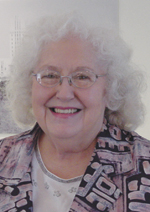



Looking back
Former
KSR employees have
fond memories of their experiences
Working
with the prisoners
was rewarding, they say
By
Helen E. McKinney
Contributing Writer
(April 2008) – “No entity has had a greater
impact on the community than the Kentucky State Reformatory,” said
Oldham County History Center Executive Director Nancy Theiss. Like many
others in Oldham and surrounding counties, Theiss has had family, friends
and neighbors who have been involved with the Reformatory in one way
or another.
 |
|
Photo
by Helen McKinney Carole
and Stanley Dawson of |
The inmates lived in her backyard while she was growing
up, so to speak. They did her family’s cooking and laundry, and
her father, Joseph Tipton Stearns, provided his veterinarian services
for the Reformatory’s farm animals.
Stearns came to Oldham County in 1941 and was the only veterinarian
around until the mid-1950s. Because of this, “they would call on
him at the Kentucky State Reformatory for vaccinations, deliveries,
etc.,” said Theiss.
She would often raise kittens and tame them, which her father would
take to the Reformatory to help control rodents. “The inmates would
‘adopt’ them,” Theiss said. In return, one inmate crafted
a tiny wooden chair in a vinegar bottle and gave it to Stearns to give
to his daughter when she was 5 years old. This is just one item on display
in the Oldham County History Center exhibit, “Serving Life: The
Kentucky State Reformatory.” Theiss, the center’s executive
director, organized the exhibit, which will run from March 15 to Aug.
15 at the La Grange museum.
Carole Dawson is another La Grange resident whose parent had ties to
the Kentucky State Reformatory. Her mother, Sue Carpenter, worked in
the mailroom and talked her daughter into applying for a job. Dawson
ended up working 32 years in the same office.
“I never felt apprehensive about going to work,” said Dawson,
who started in the Business Office when she was 19. She was the Business
Manager for the last nine years she was employed by the Reformatory.
But she did have a scare not long after beginning to work there. A riot
broke out in 1967 and all office employees were sent home. In the meantime,
she applied for another job, but as fate would have it, she didn’t
get the job. She went back to work at the Reformatory because, “I
enjoyed my job. I really liked working there.”
Several notable people visited the prison while Dawson was employed
there. These included former Kentucky Gov. Martha Layne Collins. A movie,
staring Eddie Albert, was filmed in part at the Reformatory. Dawson
recalls the Oldham County School Band playing on the front steps during
filming.
Many big name country music stars would put on a show at the Reformatory
when they came to Louisville. Loretta Lynn, George Jones, Conway Twitty
and Grandpa Jones were just a few who performed.
 |
|
Sharp |
Dawson’s husband, Stanley, worked as a correctional
officer for almost as long as his wife was employed at the Reformatory.
“When I first started, I didn’t think I’d stay there.
But it was a job.”
Roll call routinely began at 7:45 a.m. every day, with job assignments
following. For a time he worked in the Laundry Room with another correctional
officer supervising 50 inmates. At other times he worked in the dormitories
supervising as many as 200 inmates at one time.
Dawson was also a transport officer, accompanying prisoners on court
dates or to funerals. He guessed he traveled to 60 Kentucky counties
while in this position.
By 1972, the Reformatory had integrated dorms, and Dawson remembers
fights and riots breaking out for what seemed like one whole summer.
Inmates stole a lot of TVs and frequently broke into the canteen. In
the Industries area, inmates attempted to hide in trucks so they could
ride out of the prison unseen.
“We held a lot of head counts,” he said. “It kept everybody
on their toes.”
The Reformatory processed its own milk, had a cannery and killed its
own cattle and hogs. Dawson remembers great fields of green beans, potatoes,
tomatoes, corn and cabbage that inmates would plant and harvest in the
summer.
Shirley Sharp worked at the Reformatory from 1971 until 1989. She donated
items to the exhibit such as pictures, canteen script, a leather wallet
and frames made from cigarette packages by inmates.
Sharp began her career at the Reformatory as chief clerk in a program
that prepared inmates for jobs and life once they were released. She
also worked as secretary to the deputy warden, secretary when the Parole
Board came to the prison, Supervisor of Records and as a Hostage Negotiator.
Sharp said she was asked to take this last position because of her former
one as supervisor. She and another female social worker went to Richmond,
Ky., and were trained by the FBI for the position.
She remembers at least one riot at the prison, since she worked on the
documentation of it. “I had to get the files ready to send the
inmates to Eddyville,” she said.
Her husband, Allie Sharp, was deputy warden for a time. They would get
invitations from the inmates to attend programs and meetings, and they
went to show their support for the inmates. “I think if you keep
people’s minds working, it will make them better individuals,”
Sharp said.
She said she never felt afraid while working at the Reformatory, even
though working there was “almost like being in a different world.”
Sharp said she learned a lot from working at the Reformatory and hopes
she gave away something in return to the inmates.
“In there, you know what you’re dealing with. On the street,
you don’t. I never had one inmate not treat me with respect.”